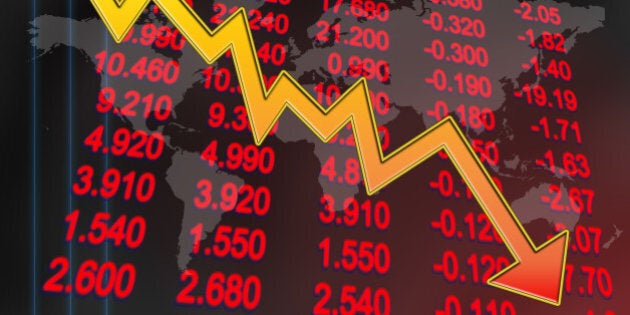
Anyone looking at stock charts these days obviously has a good reason to wonder if it is time to exit equity markets. After all, with stock indexes jumping up and down like a yo-yo, market bears are out of hibernation.
In fact, as Ivey Business Journal recently pointed out, the last time the bears prowled Bay and Wall Streets in such significant numbers was in 2009, when 1,500 finance professionals were scared enough to attend a doomsday briefing hosted by Canadian asset manager Eric Sprott.
Held at Toronto's Elgin Theatre, Sprott's gala event, entitled "A Night with the Bears," featured banking industry gurus Meredith Whitney and Stern School of Business economist Nouriel Roubini (a.k.a. Dr. Doom), who calmly explained why nobody should be calm about the global economy with debt remaining at unsustainable levels.
Ian Gordon, an uber bear from British Columbia, predicted that the Dow Jones Industrial Average would plummet to 1,000. Sprott, meanwhile, was on hand to claim that gold was the safest haven for investors.
Since then, of course, sovereign and consumer debt levels have only increased while commodity prices have tanked alongside China's economic growth rate, so thinking about rebalancing investment portfolios is clearly a good idea.
But before anyone starts selling equities today, they should keep in mind that Sprott's high-profile bears were actually roaring a lot of hot air in 2009. Following "A Night with the Bears," the world economy did slowly recover while gold prices crashed -- not the Dow.
With central bank policymakers now mostly shooting blanks, of course, the world could very well experience Great Recession 2.0. But while it is a good idea to think about rebalancing investments, it is not a good idea to let stock charts alone convince you to sell (or buy), according to research by Ivey Business School Professor Rod Duclos.
In an academic paper entitled "The psychology of investment behavior: (De)biasing financial decision-making one graph at a time," published last year by the Journal of Consumer Psychology, Duclos explains how stock charts meant to spur informed financial decision-making can actually bias an individual's evaluation of financial information and compel investors to act irrationally.
The problem with using stock graphs to decide whether or not it is time to sell a company's shares has to do with the importance that people place on observations. Simply put, the most recent past is frequently seen as more diagnostic than the distant past, and so lines on a graph can be misleading.
Duclos had two groups of research subjects examine a mock stock chart showing a month of price performance data, and then asked individuals in each group how much money they'd be willing to invest in the fictional company based on information provided.
Each group examined a chart that showed the same price average over the 30-day period, with no discernible pricing trend. The difference was pricing direction on the last day of trading, so one group saw a price bump and the other a price slump.
The study found that the final day of trading heavily influenced investing decisions when participants viewed the information in chart form. But when research subjects were given the same price performance data in non-chart format, the final day trading biases declined significantly.
"That research is really important because of the proliferation of graphical tools designed to help retail investors make sense of market data," Duclos recently told Ivey's Impact magazine. "While valuable for displaying information, graphs can lead people to place more weight on recent data when doing so is not warranted. This can make people imagine trends that have no basis in fact."
With market volatility on the rise, Duclos also says retail investors should not just think about balancing risk. "They also need to think about why they tolerate risk. My research shows a lack of love can make people who feel jilted -- or alone -- buy riskier investments as they try to fill the emotional void in their lives."
The above-mentioned insight into how relationship status can impact individual risk tolerance was featured in a 2013 article published by the Journal of Consumer Research, which was entitled "Show Me the Honey! Effects of Social Exclusion on Financial Risk-Taking."
Working with Echo Wen Wan and Yuwei Jiang -- two other marketing professors from the University of Hong Kong and Hong Kong Polytechnic University, respectively -- Duclos examined the effects of social exclusion on financial decision-making in four lab experiments and one field survey.
Simply put, the research found that feeling isolated or ostracized causes consumers to pursue riskier financial opportunities, but not due to impaired judgement or lower self-esteem. The researchers found that willingness to increase financial risk-taking when feeling disconnected or rejected stems from a heightening of what Duclos calls "the instrumentality of money."
In other words, consumer risk tolerance was found to increase as money was substituted for popularity in the pursuit of happiness. "It is important to note that this phenomenon can actually benefit consumers because financial reward levels are tied to a person's willingness to accept risk," Duclos notes. "But it is also important for both investors and the financial community to understand what drives financial decision making. Keep in mind that feelings of social isolation can be easily manipulated to increase an individual's willingness to accept risk. Furthermore, our research highlights the need for more study of social exclusion and how it influences a wide array of human behaviours."
Thomas Watson is the editor of Ivey Business Journal by the Ivey Business School at Western University in London, Ont. He can be reached at watson@ivey.ca.
Follow HuffPost Canada Blogs on Facebook
MORE ON HUFFPOST:
